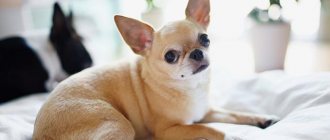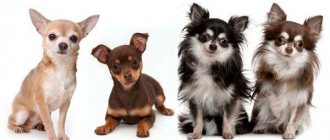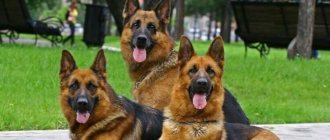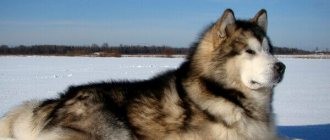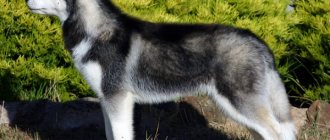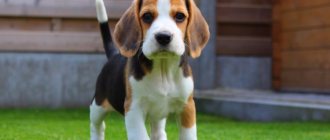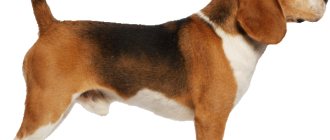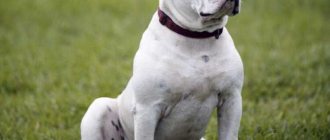Hello, dear reader! This page will help you correctly identify a Chihuahua dog and easily choose and buy a puppy of this particular breed. All little puppies are very cute, but how not to make a mistake with your choice? If you are choosing a puppy for love, then familiarize yourself with the characteristics of the breed. But, if you are really interested in the breed of the puppy, then it is a good idea to study the breed standard and find out what documents the puppy must have . Naturally, the price of puppies varies. But even an inexpensive Chihuahua puppy must meet the standard of its breed as much as possible.
Chihuahua standard
Chihuahua breed standard FCI-Standard N° 218 / 09.15.2010 / GB
BRIEF HISTORICAL SUMMARY: The Chihuahua is considered the smallest dog in the world and is named after the largest state of the Mexican Republic (Chihuahua). There is an assumption that these dogs lived in the wild, and during the Toltec civilization, they were domesticated. Images of a small dog called "Techichi" were used as decorations in urban architecture found in the city of Tula. These sculptures closely resemble real Chihuahuas .
TRANSLATION: K.Barbosov (source FCI-Standard N° 218 / 09/15/2010 / GB)
ORIGIN: Mexico. PUBLICATION DATE OF THE CURRENT OFFICIAL STANDARD: 07/29/2009 APPLICATION: Companion dogCLASSIFICATION: Group 9 – Companion and small dogsSection 6 – ChihuahuaNo operational tests
Dog care
The pet is unpretentious, he is able to live in a small apartment. However, you will have to work hard to create a sleeping place for your new pet. They buy the puppy a comfortable house or bed where he can hide from the whole world. The feeding bowl is chosen taking into account the size of the animal. This also applies to toys. The pocket dog's physique is fragile, so it will have to be constantly monitored. Even jumping from a small height can cause injury.
In the cold season, the pet freezes, so they buy warm overalls for it. Dogs often chew on various objects. You will have to hide shoes, electrical cables, and cleaning products from them.
In cold weather, the Chihuahua freezes, so the dog is dressed in overalls.
Hygiene
Caring for a dog involves performing the following procedures:
- Bathing. Such procedures cannot be carried out too often, as the wool becomes dry and brittle. Smooth-haired pets are bathed once every 3 months, long-haired pets - every 1-2 months. Before the procedure, the dog's ears are covered with cotton swabs to prevent water from penetrating into them. After bathing, dry the wool with a towel or hairdryer.
- Combing. The procedure is carried out every 3 days. Use a soft brush.
- Cleaning ears and eyes. Inspection is carried out once a week. If there is discharge in the corners of the eyes, remove them with a damp cotton pad. Dirt in the ears is removed with a cotton swab and a special lotion.
- Nail trimming. The procedure is carried out weekly. To do this, purchase a small nail clipper. Dogs do not like nail trimming, so the owner will need help.
- Cleaning the anal glands. If this procedure is not followed, the dog begins to rub its hind end against the surface. Removing gland secretions is quite difficult; it is best to entrust this procedure to a veterinarian.
- Brushing your teeth. The resulting plaque is removed with a cotton swab.
Toilet
It is quite difficult to teach a Chihuahua to relieve itself in place. You need to buy a tray with low sides for your dog. You need to ask the breeder where the puppy went to the toilet. Animals that relieve themselves in a diaper continue this habit after moving to a new home. If you don't have a skill, you can create one. After eating and sleeping, the puppy is placed in the tray. You can put a wet diaper in it that your pet used earlier. If the owner is often weaned, the dog should be kept in an enclosure equipped with a tray.
A Chihuahua dog can be litter trained.
The puppy does not immediately understand what needs to be done. However, if you continue to teach it, the skill will become fixed. They begin to take them outside to the toilet no earlier than 4 months. The animal must acquire all basic skills. During the first months, you need to go for walks often, since the puppy goes to the toilet every 2 hours. You need to walk as long as possible. The pet is taken outside after eating or sleeping. You can take a diaper with you for your pet to urinate on at home. On the street they look for places where dogs went to the toilet. The Chihuahua follows the example of its relatives and settles in immediately.
Nutrition
Small dogs have a sensitive gastrointestinal tract, so feeding only dry food negatively affects digestion. Dry food should be combined with wet food. Preference is given to super premium products. The daily feed rate is 60-70 g per 1 kg of weight. This means that a dog weighing 2 kg should eat no more than 150 g of food per day. The combination of ready-made food and natural food causes urolithiasis in pets.
Opponents of ready-made food should carefully consider their diet. The dog should be given beef, cereals, and fermented milk products. The meat must be cooked. Once a week you can treat your pet to offal, sea fish fillet, and an egg. Boiled poultry meat is given less often. Corn, rice, and buckwheat porridge are useful. Vegetables are steamed or served fresh. You can make salads seasoned with vegetable oil or sour cream. Fruits are used only as a treat.
You need to add fish oil, bone meal, olive or sunflower oil to your food. These products contain minerals, vitamins, and polyunsaturated fatty acids necessary for the dog's health.
The dog should be fed premium dry food.
You cannot feed your pet:
- fatty meats;
- candies, cookies, other sweets;
- whole milk;
- fatty and fried foods;
- river fish;
- nuts, legumes;
- bones;
- salted or pickled vegetables.
At 2 months, the puppy is fed 5-6 times a day. By 3 months, the number of meals is reduced to 4. A six-month-old pet eats more than 3 times a day. Up to a year, the dog needs to be fed the food it ate in the kennel. The diet is adjusted smoothly. The transition from natural food to dry food is extended over 4-5 weeks.
Dog food should not be hot or cold. If you need to switch your pet to natural food, use semi-moist food.
An animal older than a year eats food 2 times a day. During breaks, you can treat your four-legged friend with a special bone or cracker. An elderly dog is fed once a day, this helps avoid obesity.
How does a Chihuahua treat children?
Because the dog looks cute, a child may perceive it as a toy. However, the animal does not tolerate encroachments on its personal space. An animal is offended if it is treated with disrespect. The dog responds with aggression to many actions, so it cannot be used as a nanny. Children need to be explained that they should not teach their pet to jump off the couch or fight.
Many children perceive the Chihuahua as a toy.
Trips and walks
The dog is taken outside on a leash, which helps control the animal’s behavior. When traveling, use a closed container or carrying bag. The second option is more popular with pets. In transport, the dog may feel sick, so they give it tablets for motion sickness, and prepare a small bowl for water. For long trips, put an absorbent diaper in the bag and put a diaper on the dog. A dog traveling by plane or train must have a veterinary passport.
Head
Skull part:
Skull: Well rounded, apple-shaped (breed characteristic). Stop: Well defined, deep and wide, as the forehead is rounded and sits (“overhangs”) above the muzzle.
Front part:
Nose: any color is allowed. Moderately short, slightly upward. Eyes: Large, round, very expressive, not protruding, completely dark. Light eyes are acceptable, but not desirable.
Ears: Large, erect, wide open, wide at the base, gradually tapering to slightly rounded tips. At rest they are tilted at an angle of 45° .
Muzzle: Short, straight when viewed in profile, wide at the base, tapering towards the tip of the nose. Lips: Dry and tight fitting. Cheeks: poorly developed, very clean.
Jaws/Teeth: Scissor or level bite. Overshot, undershot, as well as any other anomaly in the position of the upper or lower jaw should be strictly punished.
Neck :
With a slightly pronounced scruff. Middle length. Thicker in males than in females. No suspension. In the long-haired variety, the presence of a “mane” is highly desirable.
Frame :
Compact and well balanced. Topline: horizontal. Withers: Slightly defined. Back: Short and strong. Loin: Very muscular. Croup: Broad and strong, almost straight or slightly sloping. Chest: Broad and deep, ribs well sprung. When viewed from the front, it is voluminous, but not extensive. When viewed from the side, it reaches the elbows. Not barrel-shaped. Underline and belly: Well defined, with a well-tucked belly. A sagging (weak) belly is acceptable, but not desirable.
Tail :
Set on high, straight, of medium length; wide at the base, gradually tapering towards the tip. The carriage of the tail is an important breed characteristic: when in motion it is carried either high, curved or in the shape of a semicircle with the tip directed towards the lumbar region, which gives balance to the body. The tail should never be carried between the hindquarters or below the line of the back. The hair on the tail depends on the coat variety and must correspond to it. In the long-haired variety, the hair on the tail forms a plume. When at rest, the tail is lowered and forms a small hook.
How to choose a puppy
The breed is considered exclusive, expensive and glamorous. To get a truly high-quality purebred puppy, you need to contact a nursery. A good breeder will definitely present all the necessary documents and tell the potential owner about the breed line, parents, and possible diseases. He will help you decide on a puppy.
First of all, you need to decide on the gender, age and class of the future pet. The character of the dog depends on the gender, and the cost depends on the age and class. You can pick up a puppy from its mother at 2-3 months ; small puppies are easier to raise, but they require more attention. At 5-6 months, pets acquire the appearance of an adult dog, but they are more expensive and more difficult to train.
The class is awarded to puppies that have already grown up, but breeders make a prediction.
- Pet class - pets for home keeping, which may have deviations from the standards.
- Breeding class – dogs with ideal conformation, suitable for breeding.
- Show class – exhibition animals with high-quality pedigree.
The puppies are very small and cute, but quite fragile. It is difficult to judge a dog's future appearance by its exterior. But they should not have obvious pathologies and deviations. The average cost is 10-60 thousand rubles .
Limbs:
Forelegs:
General appearance: The forelimbs are straight and parallel when viewed from the front. Vertical when viewed from the side. Shoulders: Smooth and moderately muscular. The angles of the humeroscapular joints are well defined. Elbows: Strong and close to the body, allowing free movement. Forearms: Straight and of good length. Pasterns: Slightly sloping, strong and flexible. Feet: Very small and oval, with well-spaced but not splayed toes (neither hare's nor cat's feet). The claws are well arched and moderately long. The pads are well developed and very elastic. Dewclaws are not desirable.
Hind limbs:
General appearance: The hind legs are muscular with long bones, vertical and parallel to each other, with good angulation of the hip, knee and hock joints, in harmony with the angulation of the forelegs. Metatarsals: hocks are short, with well-developed Achilles tendons; when viewed from behind, straight and vertical are well spaced from each other. Feet: Very small and oval, with well-spaced but not splayed toes (neither hare's nor cat's feet). The claws are well arched and moderately long. The pads are well developed and very elastic. Dewclaws are not desirable.
Movements:
The steps are long, elastic, energetic and active, with good reach of the front legs and drive of the hind legs. When viewed from behind, the hind legs should move almost parallel to each other, so that the tracks of the hind legs coincide with the tracks of the front ones. With increasing speed, there is a tendency for the center of gravity to shift (single step). The movements are stable, free and springy, without visible effort, the head is raised, the back is straight.
Leather:
Smooth and tight fitting throughout the body.
Features of character and behavior
Sneezes are small but unique dogs. They have a difficult character. Some consider these pets to be nervous, unbalanced, and aggressive. Owners look for differences in character between smooth-haired and long-haired pets, but one litter can have completely different puppies.
The wild life of dogs in the forest had a negative impact on the development of temperament. They had to protect each other from people, run away and hide, because they did not have the strength to defeat large creatures.
The majority of dogs are playful, active and active. But they are quite nervous and can become aggressive and embittered.
Advantages
The advantages of the breed include:
- Activity, positivity;
- High adaptability to living conditions and circumstances;
- Devotion to the owners;
- Good security abilities (Sneezes will bark and become a real alarm when danger threatens or even when strangers appear on the territory);
- Chihuahuas can serve deaf people (they bring phones or notify people when guests arrive);
- High intellectual abilities, quick learner;
- Connection with the owner (dogs sense a person’s mood).
Flaws
Flaws may vary from individual to individual. Chihuahuas are a very variable breed, so their personalities are unpredictable. One way or another, with proper upbringing, temperament problems are eliminated. Breed disadvantages that are most often encountered:
- Stubbornness;
- Intolerance of loneliness, constant need for attention, care and affection;
- Zealous attitude towards the owner;
- Distrust of strangers, outbursts of aggression;
- Nervousness, weak psyche;
- Tendency to dominate.
Wool
There are two varieties in the breed:
Shorthair:
The coat is short and lies tightly all over the body. If there is an undercoat, the coat is somewhat longer; sparse hair on the throat and belly is allowed; slightly longer on the neck and tail, short on the head and ears. The coat is shiny and its texture is soft. Lack of wool is not allowed.
Longhair:
The coat should be fine and silky, smooth or slightly wavy. A not too thick undercoat is desirable. The coat is longer and forms feathers - on the ears, neck, on the back of the front and hind legs, on the paws and tail. Long flowing hair is not acceptable.
Color:
Any color is acceptable , with the exception of merle color.
Size and weight:
In the breed, only weight is taken into account, not height. Weight: Ideal weight: from 1.5 to 3 kilograms. Weight from 500 gr. up to 1.5 kg is acceptable. Dogs weighing less than 500 grams and more than 3 kg must be disqualified.
History of the origin of the species
The homeland of miniature dogs is sunny Mexico, namely the state of Chihuahua, after which the breed was named. The exact time of appearance is unknown, approximately 4-5 century AD.
Long-haired little Techichi were found and tamed by the ancient Toltec tribes. Back then, wealthy Indians kept several dogs in their houses. There is a version that they were mute. One way or another, pets were used for religious purposes. It was believed that they carried the souls of the deceased to another world, so when the owner died, the dog was mummified and buried with him.
In 1850, an American archaeologist found figurines, mummies and rock paintings of Techichi in the temple of Montezuma (Mexico), similar in appearance to modern Chihuahuas.
A few centuries later, Mexico was filled with the Aztec and Mayan tribes. They became the new masters of Techichi. People still honored dogs and used them for religious purposes. The nightmare for the dogs was that now they were not only mummified, but also eaten.
At the beginning of the 16th century, the conquistadors conquered Mexico and the Techichi population declined sharply. Animals were killed and eaten. In addition, the Chinese Cresteds, who arrived on ships with people, mixed with Techichi, the breed changed its appearance. The smartest individuals fled to the forest, where they lived in isolation until the 19th century. Most likely due to this brutal attitude, Chihuahuas are aggressive towards strangers and children.
In the years 1870-1890, Mexicans found cute little dogs in the forest and decided to sell them. Delighted Americans bought baskets of Chikhov on the Mexican border. In 1884, the first breed exhibition was organized in Philadelphia. In 1904 the dog was entered into the American stud book, and in 1907 into the English stud book. The club opened in 1923.
Now the breed is considered national in Mexico. Puppies are given as gifts only to the most dear guests and close people. The tradition was started by the president, who gave singer Adelina Patti a bouquet of flowers with a dog in it.
Flaws
Any deviation from the above points should be considered a fault, and the seriousness with which the fault should be regarded should be in exact proportion to its degree and its effect on the health and welfare of the dog. • Missing teeth. • “Double teeth” (preservation of temporary teeth). • pointed ears. • Short neck. • Long body. • Humped or sunken back (lordosis or kyphosis). • Beveled croup. • Narrow or flat chest. • Tail: incorrectly set, short or curled. • Short limbs. • Loose elbows. • Narrow set of hind legs.
Key points in training
Training a breed can be a challenging task, so education is the first issue. They need to be taught order and family hierarchy. A small lap dog should not be allowed to sit on a person’s neck. She must remember several rules: eating only after the family gets up from the table (begging is suppressed), entering the house after household members, sleeping and playing on the owner’s furniture is prohibited.
After the puppy remembers the name and gets used to his schedule, you can try to teach him basic commands that will help control the pet: sit, next to me, not allowed, quiet.
Contacting cynological services and clubs will make the owner’s work easier. Plus, pets are better trained in a group. Chihuahuas are good at agility, so a course with obstacles will be a good workout and a way to concentrate.
Read about how to properly train a dog in the article: “Training a puppy: effective methods from dog handlers, learning commands at home.”
Disqualifying faults
• Aggressive or overly fearful. • Any dog clearly showing physical or behavioral abnormalities must be disqualified • Dogs with an open fontanel. • Cropped or short ears. • Deformed jaws. • Extremely long body. • No tail. • In the long-haired variety: dogs with very long, fine and flowing hair. • In the short-haired variety: baldness (alopecia). • Merle color. • Dogs weighing less than 500 grams. and more than 3 kg. NB: Males must have two apparently normal testes, fully descended into the scrotum.
- Post from 04/24/15
- National Chihuahua Breed Club
Description of the breed
Modern sneezes don't look exactly like their ancestors. This is explained by many years of experiments on crossing with representatives of other small breeds. Today you can find the genes of Spitz, Papillon and Toy terriers in them. The main modern breed criteria include:
- low weight and height;
- limited number of colors;
- short-haired or long-haired;
- two body types (cobby and dir);
- life expectancy is 13-15 years.
Colors
The Chihuahua breed can be any color, with the exception of merle: dogs of this color are born with genetic diseases.
The pet's passport indicates one of 12 possible colors and their varieties.
White
Such dogs are snow-white, without spots or specks. The nose is black, brown or pink, and the rims of the lips and eyes are light.
33 breeds of white dogs.
Black
There are three varieties:
- Pure black. Completely black or with a small white spot on the chest. Snow-white paw tips are also allowed.
- Black and white. Against a dark background, light spots on the paws, chest, and tip of the tail stand out well. Markings of the same color on the neck and head are acceptable.
- White black. The main color is snow-white, with black spots on the body and/or head contrasting with it.
42 black dog breeds.
Blue
Pure blue color is also called diluted. Pets of this color are almost completely blue, not counting small light inclusions. The lobe, rim of the eyes and lips are gray.
Like the previous suit, blue has two subtypes: in combination with snow-white spots and white-blue.
Chocolate
With a purely chocolate color, the dog is all or almost completely brown. Varieties: chocolate with snow-white and white-chocolate.
Lilac
Another name is bleached brown. The coat is completely lilac (with possible snow-white spots), the nose, rims of the lips, and eyes are the same color.
There are also two varieties of this suit: lilac and white and white and lilac.
Sable
Sable colors include many types of colors and their varieties:
- Fawn with blackening. Sable with tan and dark tips of hair on the ears, head, back, tail. The nose, eye and lip rims are also black. There may be light marks on the fingers and on the chest. It is divided into two subspecies: with snow-white splashes and white-fawn with blackening.
- Red with blackening. Sable-red coloring with dark tips of hairs and possible snow-white spots. Nose, eyelids, lips - black. Like other colors, there are two subtypes: with white markings and white-red.
- Fawn with blue shading. Blue-fawn, with possible light markings. The ends of the hair, nose, lips, eyelids are gray. The varieties are the same: with light spots on a fawn background and white-fawn with blue shading.
- Red with blue shading. Combines red and blue-sable colors. The nose, lips, eyes are gray, the ends of the hair are bluish. Light spots on the paws and chest are allowed. Subspecies: with light markings and white-red with blue shading.
- Fawn with chocolate shading. The fawn color is combined with brown tips of the coat. The color of the nose, eyes, lips - in that darkening. Snow-white inclusions are allowed. This color also has two varieties: with light markings and white-fawn with chocolate shading.
- Red with chocolate shading. Similar to other sable colors, but the tips of the hair are colored red, and the lips, eyes, and nose are brown. There are also subspecies with light spots and white-red with chocolate darkening.
- Fawn with a lilac tint. The main color is fawn, and the tips of the hairs are colored purple. There are color combinations with light splashes or a white background with fawn-lilac spots.
Ginger
Like other colors, there are three types:
- Intense red. Pure red without darkening.
- Red with white spots. Light areas are clearly visible on the red background.
- White and red. The white coat is decorated with pure red markings on the head or body.
40 breeds of dogs with red color.
Pale yellow
Pure fawn color is characterized by a light red coat color without darkening. There may be light spots on the chest and paws.
Subspecies are also distinguished: fawn with light splashes and white-fawn.
Cream
It is also called highly bleached red. With this color, the coat is cream-colored. As in other colors, lightened markings on the paws and chest are allowed.
The varieties are the same: with light markings and white-cream.
Tan
There are four main types and their varieties in this color.
- Black and tan. Pure black with tan and possible snow-white splashes on the chest and tips of the paws. Subspecies: with light markings and tricolor with a predominant white background (more than 50%).
- Chocolate and tan. It also exists in three varieties: pure chocolate and tan, with snow-white spots and tri-color.
- Blue and tan. Clean, with white markings and tricolor.
- Lilac and tan. The lilac background is combined with light red tan. The subspecies are the same: with snow-white spots and tricolor.
brindle
Rare and interesting color. On a fawn or red background there are alternating vertical stripes of any size. They can be rare or so frequent that they almost completely hide the main suit.
With brindle color, the stripes are eumelanin, i.e. dark shades: black, chocolate, blue, lilac, red.
Maroon
Also an unusual color. The main color of the fur coat is white. It is complemented by small spots (speckles) of various sizes and in any quantity. Their color must match the color of the dog.
Reviews
The dog is not capricious, does not require much attention, but if the owner gives her a minute of time, she will be infinitely happy. The Chihuahua looks funny and can be dressed up in fashionable costumes. The pet does not like to bathe.
The baby eats only natural food (turkey meat, cottage cheese, vegetables). For a treat, a Chihuahua is willing to endure having its nails trimmed. Prefers to sit in his arms and lie on a warm rug. The dog cannot tolerate cold and cold.
The dog loves attention and often begs for treats. Children love to play with the baby, but you need to be careful that they do not harm her. Chihuahuas are difficult to toilet train and require a lot of time to convince them to defecate in the diaper.
The Chihuahua is a pocket dog originally from Mexico. Body weight does not exceed 3 kg. Caring for babies is not difficult, they do not bring much trouble, they are distinguished by affection, playfulness and endless devotion to their owner.
Breeding
The best time for chihuahua offspring is when the female is three years old. But the dog has a hard time with pregnancy and childbirth. The optimal breeding period for a dog varies between 3-8 years.
Useful article: Pregnancy and childbirth in Chihuahuas: details by day
Expert opinion
Anna Abramenko
An avid dog lover. Experience in veterinary medicine since 2009.
Ask a Question
Before breeding, your dog should be examined by a veterinarian. A female Chihuahua must have excellent health, just like a male. Mating takes place on the 10-14th day of estrus. The first time, things often don’t work out, especially if the bitch doesn’t like the male. But then everything goes without problems.
At first, it is difficult to determine if a Chihuahua is pregnant, as the dog behaves as usual. But later the animal becomes calmer, eats more and sleeps a lot. Then the dog’s belly grows and its weight increases. 2 weeks before giving birth, you can test Chihuahua puppies.
The animal's pregnancy lasts approximately 2 months. A caesarean section under general anesthesia is often required. 1-3 puppies are born. It may be higher in a large female who has given birth several times. Chihuahua babies usually weigh from 70 to 150 g and are 10 cm tall.
The next mating is possible 6-8 months after birth. The animal needs to get stronger and recover.
Interesting Facts
Before you get a little pet, you should find out as much as possible about it:
- The dog easily finds a common language with the family, but remains most devoted to one person. He gets along only with his own breed, but is aggressive towards others.
- The smallest Chihuahua in the world, named Brandy, is 15.2 cm long from nose to tail.
- Compared to the body, such an animal has the largest brain size among other breeds.
- According to one version, Christopher Columbus is associated with the appearance of animals in Mexico, who in a letter to the king spoke about unusual crumbs.
Muzzle
Photo: Chihuahua face according to the standard
According to the standard, the face of a Chihuahua should look like this:
- The Chihuahua's skull is small, wide at the base and tapering towards the nose.
- The nose is neat and short, looking up.
- Lips and cheeks are dry, poorly expressed.
- The standard bite is straight or scissor.
- The eyes are large and beautiful, preferably non-protruding and dark in color.
- The ears are large and erect, rounded upward, and in a calm state may be slightly drooping.
